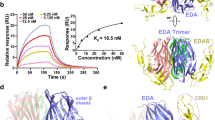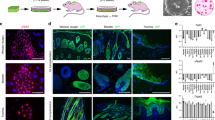Abstract
TABBY (Ta)1, a murine X-linked mutant gene, produces a syndrome of ectodermal dysplasia including anhidrosis2 (absence of sweat glands). Development of sweat glands is related to that of dermal ridges (dermatoglyphyics)3 and abnormal ridges may be associated with absence of sweat glands4 in the human syndrome of hypohidrotic ectodermal dysplasia (HED)5. We have found that dermal ridges occur in normal mice but are lacking in Ta mutants. Previously we showed that epidermal growth factor (EGF) reverses delayed eyelid opening and incisor eruption in Ta mice6. We now report that EGF induces development of dermal ridges and functional sweat glands in Ta/Y hemizygotes, indicating a role in mammalian morphogenesis7. Ta seems to be genetically homologous to human X-linked HED2, as Ta maps close to loci homologous to linkage markers of HED8 and the two syndromes share many traits, including absence of all or most sweat glands2. Absence of these glands causes hyperpyrexia, a clinical emergency in infants with HED ; reversal of the trait in the mouse homologue of the disease indicates that an important genetically determined congenital defect in humans may become treatable.
This is a preview of subscription content, access via your institution
Access options
Subscribe to this journal
Receive 51 print issues and online access
$199.00 per year
only $3.90 per issue
Buy this article
- Purchase on Springer Link
- Instant access to full article PDF
Prices may be subject to local taxes which are calculated during checkout
Similar content being viewed by others
References
Falconer, D. S. Nature 169, 664–665 (1952).
Blecher, S. R. J. invest. Derm. 87, 720–722 (1986).
Penrose, L. S. & Ohara, P. T. J. med. Genet. 10, 201–208 (1973).
Frydman, M., Cohen, H. A., Kauschansky, A. & Matoth, Y. Am. J. med. Genet. 31, 591–596 (1988).
Freire-Maia, N. & Pinheiro, M. Ectodermal Dysplasias: A Clinical and Genetic Study (Liss, New York, 1984).
Kapalanga, J. & Blecher, S. R. Development 108, 349–355 (1990).
Mercola, M. & Styles, C. D. Development 102, 451–460 (1988).
Zonana, J. et al. Am. J. hum. Genet. 43, 75–85 (1988).
Kirkeby, S. & Blecher, S. R. Arch. Androl. 6, 163–173 (1981).
Harper, R. A. Expl. Cell Res. 178, 254–263 (1988).
Coleman, S., Silberstein, G. B. & Daniel, C. W. Devl Biol. 127, 304–315 (1988).
Goldin, G. V. & Opperman, L. A. J. Embryol. exp. Morph. 60, 235–243 (1980).
Weeks Robertson, N. L. thesis, Dalhousie Univ., Canada (1985).
Cohen, S. J. biol. Chem. 237, 1555–1562 (1962).
Marti, U., Burwen, S. J. & Jones, A. L. Hepatology 9, 126–138 (1989).
Carpenter, G. Science 210, 198–199 (1980).
King, L. E. & Carpenter, G. F. Biochemistry and Physiology of the Skin. (ed Goldsmith, L.) (Oxford University Press, 1983).
Rail, L. B., et al. Nature 313, 228–231 (1985).
Heller, N.-H. & Blecher, S. R. Archs oral Biol. 27, 325–329 (1982).
Vigier, B., Watrin, F., Magre, S., Tran, D. & Josso, N. Development 100, 43–55 (1987).
Sporn, M. B. & Roberts, A. B. Nature 313, 745–747 (1985).
Buckley, A., Davidson, J. M., Kamerath, C. D., Wolt, T. B. & Woodward, S. C. Proc. natn. Acad. Sci. U.S.A. 82, 7340–7344 (1985).
Gruneberg, H. J. Embryol. exp. Morph. 15, 223–244 (1966).
Gruneberg, H. J. Embryol. exp. Morph. 25, 1–19 (1971).
Blecher, S. R., Debertin, M. & Murphy, J. S. Anat. Rec. 207, 25–29 (1983).
Greenwald, I. Cell 43, 583 (1985).
Kidd, S., Kelley, M. R. & Young, M. W. Molec. Cell Biol. 6, 3094–3108 (1986).
Hursh, D. A., Andrews, M. E. & Raff, R. A. Science 237, 1487–1490 (1987).
Riedel, H., Schlessinger, J. & Ullrich, A. Science 236, 197–200 (1987).
Ohno, S. Sex chromosomes and Sex-linked Genes. Monographs on Endocrinology Vol. 1 (Springer, New York, 1967).
Blecher, S. R. et al. Anat. Rec. 202, 17A (1982).
Hayashi, H. Tohoku J. exp. Med. 95, 289–295 (1968).
Author information
Authors and Affiliations
Rights and permissions
About this article
Cite this article
Blecher, S., Kapalanga, J. & Lalonde, D. Induction of sweat glands by epidermal growth factor in murine X-linked anhidrotic ectodermal dysplasia. Nature 345, 542–544 (1990). https://doi.org/10.1038/345542a0
Received:
Accepted:
Issue Date:
DOI: https://doi.org/10.1038/345542a0
This article is cited by
-
Histological detection of dynamic glial responses in the dysmyelinating Tabby-jimpy mutant brain
Anatomical Science International (2018)
-
Gene-activated matrix/bone marrow-derived mesenchymal stem cells constructs regenerate sweat glands-like structure in vivo
Scientific Reports (2017)
-
Adult bone-marrow-derived mesenchymal stem cells contribute to wound healing of skin appendages
Cell and Tissue Research (2006)
-
Cultivation of epithelia from the secretory coil of the ovine apocrine gland: Evidence of secretory cell function and ductal morphogenesis In vitro
In Vitro Cellular & Developmental Biology - Animal (1999)
-
Two genes for missing teeth
Nature Genetics (1996)
Comments
By submitting a comment you agree to abide by our Terms and Community Guidelines. If you find something abusive or that does not comply with our terms or guidelines please flag it as inappropriate.



